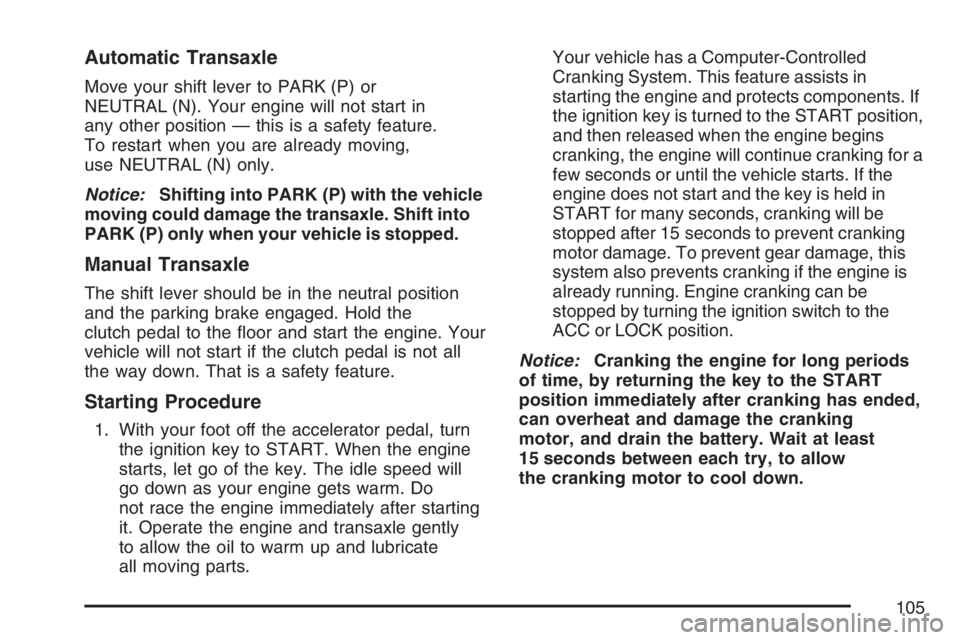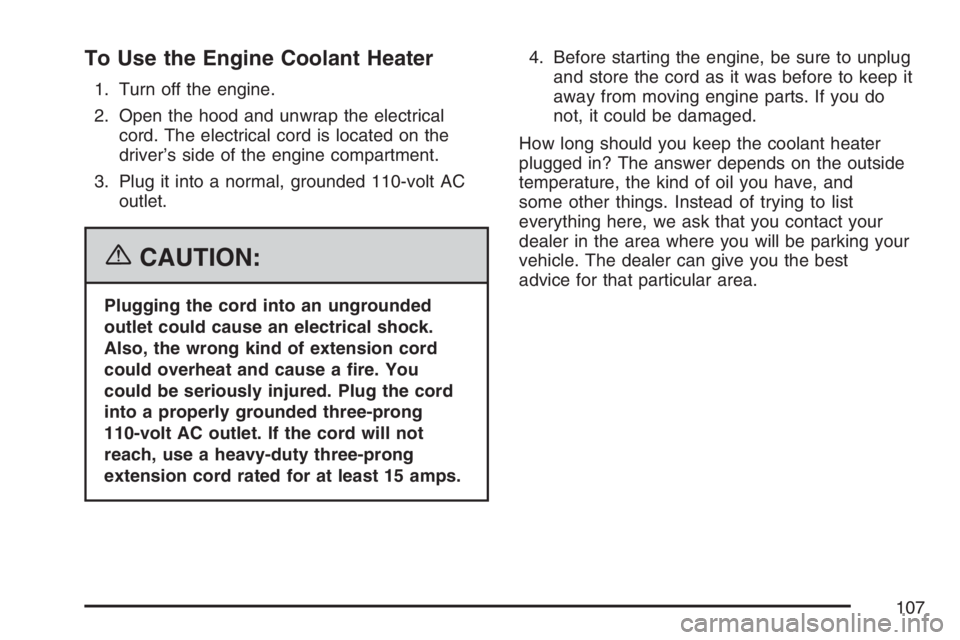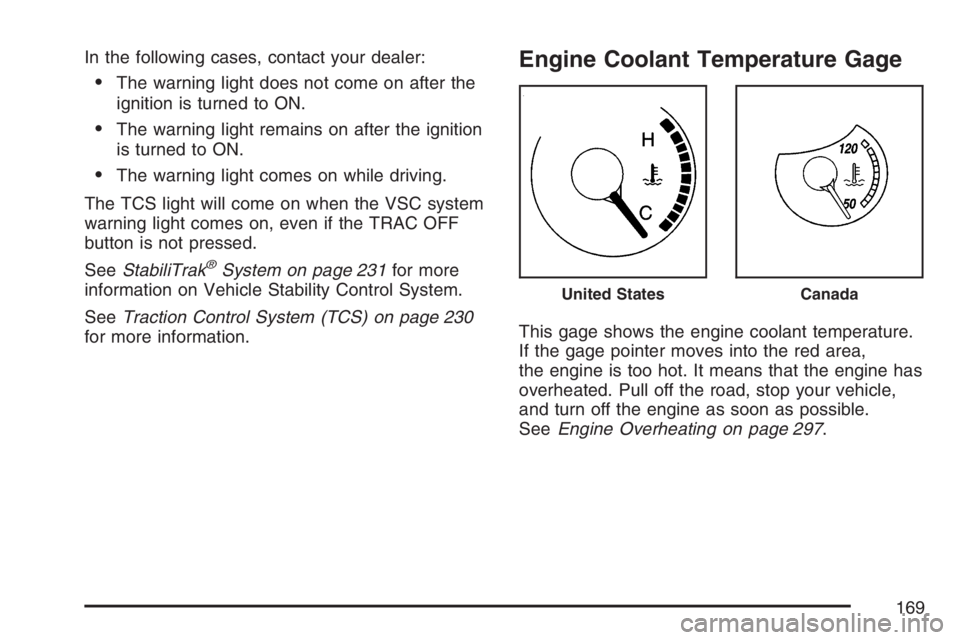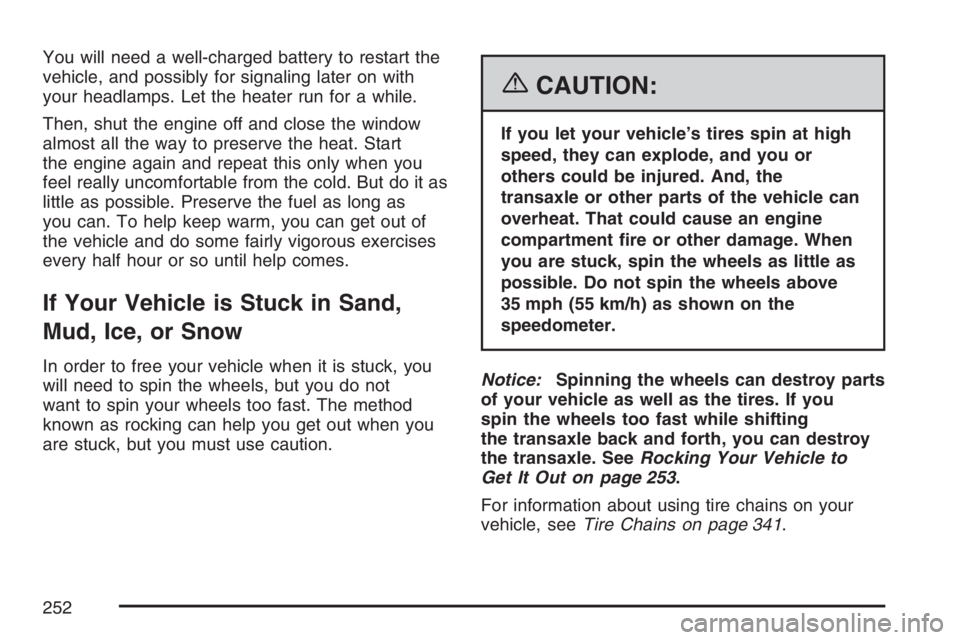engine overheat PONTIAC VIBE 2007 Owners Manual
[x] Cancel search | Manufacturer: PONTIAC, Model Year: 2007, Model line: VIBE, Model: PONTIAC VIBE 2007Pages: 432, PDF Size: 2.54 MB
Page 105 of 432

Automatic Transaxle
Move your shift lever to PARK (P) or
NEUTRAL (N). Your engine will not start in
any other position — this is a safety feature.
To restart when you are already moving,
use NEUTRAL (N) only.
Notice:Shifting into PARK (P) with the vehicle
moving could damage the transaxle. Shift into
PARK (P) only when your vehicle is stopped.
Manual Transaxle
The shift lever should be in the neutral position
and the parking brake engaged. Hold the
clutch pedal to the �oor and start the engine. Your
vehicle will not start if the clutch pedal is not all
the way down. That is a safety feature.
Starting Procedure
1. With your foot off the accelerator pedal, turn
the ignition key to START. When the engine
starts, let go of the key. The idle speed will
go down as your engine gets warm. Do
not race the engine immediately after starting
it. Operate the engine and transaxle gently
to allow the oil to warm up and lubricate
all moving parts.Your vehicle has a Computer-Controlled
Cranking System. This feature assists in
starting the engine and protects components. If
the ignition key is turned to the START position,
and then released when the engine begins
cranking, the engine will continue cranking for a
few seconds or until the vehicle starts. If the
engine does not start and the key is held in
START for many seconds, cranking will be
stopped after 15 seconds to prevent cranking
motor damage. To prevent gear damage, this
system also prevents cranking if the engine is
already running. Engine cranking can be
stopped by turning the ignition switch to the
ACC or LOCK position.
Notice:Cranking the engine for long periods
of time, by returning the key to the START
position immediately after cranking has ended,
can overheat and damage the cranking
motor, and drain the battery. Wait at least
15 seconds between each try, to allow
the cranking motor to cool down.
105
Page 107 of 432

To Use the Engine Coolant Heater
1. Turn off the engine.
2. Open the hood and unwrap the electrical
cord. The electrical cord is located on the
driver’s side of the engine compartment.
3. Plug it into a normal, grounded 110-volt AC
outlet.
{CAUTION:
Plugging the cord into an ungrounded
outlet could cause an electrical shock.
Also, the wrong kind of extension cord
could overheat and cause a �re. You
could be seriously injured. Plug the cord
into a properly grounded three-prong
110-volt AC outlet. If the cord will not
reach, use a heavy-duty three-prong
extension cord rated for at least 15 amps.4. Before starting the engine, be sure to unplug
and store the cord as it was before to keep it
away from moving engine parts. If you do
not, it could be damaged.
How long should you keep the coolant heater
plugged in? The answer depends on the outside
temperature, the kind of oil you have, and
some other things. Instead of trying to list
everything here, we ask that you contact your
dealer in the area where you will be parking your
vehicle. The dealer can give you the best
advice for that particular area.
107
Page 116 of 432

Leaving Your Vehicle With the Engine
Running (Automatic Transaxle)
{CAUTION:
It can be dangerous to leave your vehicle
with the engine running. Your vehicle
could move suddenly if the shift lever is
not fully in PARK (P) with the parking
brake �rmly set. And, if you leave the
vehicle with the engine running, it could
overheat and even catch �re. You or
others could be injured. Do not leave your
vehicle with the engine running.
If you have to leave your automatic transaxle
vehicle with the engine running, be sure your
vehicle is in PARK (P) and your parking brake is
�rmly set before you leave it. After you have moved
the shift lever into PARK (P), hold the regular brake
pedal down. Then, see if you can move the shift
lever away from PARK (P) without �rst pulling it
toward you. If you can, it means that the shift lever
was not fully locked into PARK (P).
Torque Lock (Automatic Transaxle)
If you are parking on a hill and you do not shift into
PARK (P) properly, the weight of the vehicle
may put too much force on the parking pawl in the
transaxle. You may �nd it difficult to pull the
shift lever out of PARK (P). This is called “torque
lock.” To prevent torque lock, set the parking
brake and then shift into PARK (P) properly before
you leave the driver’s seat. To �nd out how, see
Shifting Into Park (P) (Automatic Transaxle)
on page 115.
When you are ready to drive, move the shift lever
out of PARK (P) before you release the parking
brake.
If torque lock does occur, you may need to have
another vehicle push yours a little uphill to
take some of the pressure from the parking pawl
in the transaxle, so you can pull the shift lever
out of PARK (P).
116
Page 169 of 432

In the following cases, contact your dealer:
The warning light does not come on after the
ignition is turned to ON.
The warning light remains on after the ignition
is turned to ON.
The warning light comes on while driving.
The TCS light will come on when the VSC system
warning light comes on, even if the TRAC OFF
button is not pressed.
SeeStabiliTrak
®System on page 231for more
information on Vehicle Stability Control System.
SeeTraction Control System (TCS) on page 230
for more information.
Engine Coolant Temperature Gage
This gage shows the engine coolant temperature.
If the gage pointer moves into the red area,
the engine is too hot. It means that the engine has
overheated. Pull off the road, stop your vehicle,
and turn off the engine as soon as possible.
SeeEngine Overheating on page 297.
United StatesCanada
169
Page 252 of 432

You will need a well-charged battery to restart the
vehicle, and possibly for signaling later on with
your headlamps. Let the heater run for a while.
Then, shut the engine off and close the window
almost all the way to preserve the heat. Start
the engine again and repeat this only when you
feel really uncomfortable from the cold. But do it as
little as possible. Preserve the fuel as long as
you can. To help keep warm, you can get out of
the vehicle and do some fairly vigorous exercises
every half hour or so until help comes.
If Your Vehicle is Stuck in Sand,
Mud, Ice, or Snow
In order to free your vehicle when it is stuck, you
will need to spin the wheels, but you do not
want to spin your wheels too fast. The method
known as rocking can help you get out when you
are stuck, but you must use caution.
{CAUTION:
If you let your vehicle’s tires spin at high
speed, they can explode, and you or
others could be injured. And, the
transaxle or other parts of the vehicle can
overheat. That could cause an engine
compartment �re or other damage. When
you are stuck, spin the wheels as little as
possible. Do not spin the wheels above
35 mph (55 km/h) as shown on the
speedometer.
Notice:Spinning the wheels can destroy parts
of your vehicle as well as the tires. If you
spin the wheels too fast while shifting
the transaxle back and forth, you can destroy
the transaxle. SeeRocking Your Vehicle to
Get It Out on page 253.
For information about using tire chains on your
vehicle, seeTire Chains on page 341.
252
Page 267 of 432

Driving On Grades
Reduce speed and shift to a lower gearbefore
you start down a long or steep downgrade. If you
don’t shift down, you might have to use your
brakes so much that they would get hot and no
longer work well.
On a long uphill grade, shift down and reduce
your speed to around 45 mph (70 km/h) to reduce
the possibility of the engine and the transaxle
overheating.
Parking on Hills
{CAUTION:
You really should not park your vehicle,
with a trailer attached, on a hill. If
something goes wrong, your rig could
start to move. People can be injured, and
both your vehicle and the trailer can be
damaged.But if you ever have to park your rig on a hill,
here’s how to do it:
1. Apply your regular brakes, but don’t shift into
PARK (P) for an automatic transaxle or into
gear for a manual transaxle, yet. When
parking uphill, turn your wheels away from the
curb. When parking downhill, turn your
wheels into the curb.
2. Have someone place chocks under the trailer
wheels.
3. When the chocks are in place, release the
regular brakes until the chocks absorb the load.
4. Reapply the regular brakes. Then apply your
parking brake and shift into PARK (P) for an
automatic transaxle or REVERSE (R) for
a manual transaxle.
5. Release the regular brakes.
267
Page 268 of 432

When You Are Ready to Leave After
Parking on a Hill
1. Apply your regular brakes and hold the pedal
down while you:
start your engine
shift into a gear, and
release the parking brake
2. Let up on the brake pedal.
3. Drive slowly until the trailer is clear of the
chocks.
4. Stop and have someone pick up and store the
chocks.
Maintenance When Trailer Towing
Your vehicle will need service more often when
you’re pulling a trailer. See the Maintenance
Schedule for more on this. Things that are
especially important in trailer operation are
automatic transaxle �uid (don’t over�ll), engine oil,
drive belt, cooling system and brake system.
Each of these is covered in this manual, and the
Index will help you �nd them quickly. If you’re
trailering, it’s a good idea to review this information
before you start your trip.
Check periodically to see that all hitch nuts and
bolts are tight.
Engine Cooling When Trailer Towing
Your cooling system may temporarily overheat
during severe operating conditions. SeeEngine
Overheating on page 297.
268
Page 269 of 432

Service........................................................ 272
Accessories and Modi�cations................... 272
California Proposition 65 Warning.............. 273
Doing Your Own Service Work.................. 273
Adding Equipment to the Outside of
Your Vehicle.......................................... 274
Fuel............................................................. 274
Gasoline Octane........................................ 274
Gasoline Speci�cations.............................. 274
California Fuel........................................... 275
Additives................................................... 275
Fuels in Foreign Countries........................ 276
Filling the Tank......................................... 277
Filling a Portable Fuel Container............... 279
Checking Things Under the Hood.............. 280
Hood Release........................................... 280
Engine Compartment Overview.................. 282
Engine Oil................................................. 284
Engine Air Cleaner/Filter............................ 288
Automatic Transaxle Fluid......................... 290Manual Transaxle Fluid............................. 292
Hydraulic Clutch........................................ 293
Engine Coolant.......................................... 294
Radiator Pressure Cap.............................. 297
Engine Overheating................................... 297
Cooling System......................................... 299
Power Steering Fluid ................................. 304
Windshield Washer Fluid........................... 305
Brakes...................................................... 306
Battery...................................................... 309
Jump Starting............................................ 310
Bulb Replacement....................................... 315
Halogen Bulbs........................................... 315
Headlamps, Front Turn Signal, and
Parking Lamps....................................... 316
Center High-Mounted
Stoplamp (CHMSL)................................ 317
Taillamps, Turn Signal, and Stoplamps...... 318
Back-Up Lamps......................................... 320
Replacement Bulbs................................... 320
Section 5 Service and Appearance Care
269
Page 290 of 432

Automatic Transaxle Fluid
When to Check and Change Automatic
Transaxle Fluid
A good time to check your automatic transaxle
�uid level is when the engine oil is changed.
Check the �uid in the transaxle and differential
at the intervals listed inPart A: Scheduled
Maintenance Services on page 376, and
be sure to use the transaxle �uid listed in
Part D: Recommended Fluids and Lubricants
on page 394.
How to Check Automatic Transaxle
Fluid
Because this operation can be a little difficult, you
may choose to have this done at the dealership
service department.
If you do it yourself, be sure to follow all the
instructions here, or you could get a false reading
on the dipstick.Notice:Too much or too little �uid can damage
the transaxle. Too much can mean that some of
the �uid could come out and fall on hot engine
or exhaust system parts, starting a �re. Too
little �uid could cause the transaxle to overheat.
Be sure to get an accurate reading if you check
the transaxle �uid.
Wait at least 30 minutes before checking the
transaxle �uid level if you have been driving:
When outside temperatures are above 90°F
(32°C).
At high speed for quite a while.
In heavy traffic — especially in hot weather.
While pulling a trailer.
To get the right reading, the �uid should be at
normal operating temperature, which is 158°F to
176°F (70°C to 80°C).
Get the vehicle warmed up by driving about
15 miles (24 km) when outside temperatures are
above 50°F (10°C). If it is colder than 50°F (10°C),
you may have to drive longer.
290
Page 292 of 432

How to Add Automatic Transaxle Fluid
Refer to the Maintenance Schedule to
determine what kind of transaxle �uid to use.
SeePart D: Recommended Fluids and Lubricants
on page 394.
If the �uid level is low, add only enough of the
proper �uid to bring the level into the area between
dimples on the dipstick.
1. Pull out the dipstick.
2. Using a long-neck funnel, add enough �uid at
the dipstick hole to bring it to the proper level.
It does not take much �uid, generally less
than one pint (0.5 L). Do not over�ll.
Notice:Use of the incorrect automatic
transaxle �uid may damage your vehicle, and
the damages may not be covered by your
warranty. Always use the automatic transaxle
�uid listed inPart D: Recommended Fluids
and Lubricants on page 394.
3. After adding �uid, recheck the �uid level as
described under “How to Check Automatic
Transaxle Fluid,” earlier in this section.4. When the correct �uid level is obtained, push
the dipstick back in all the way; then press the
tab down to lock the dipstick in place.
Manual Transaxle Fluid
When to Check
A good time to have your manual transaxle �uid
level checked is when the engine oil is changed.
However, the �uid in your manual transaxle
does not require changing.
How to Check
Because this operation can be difficult, you may
choose to have this done at your Pontiac
dealership service department.
If you do it yourself, be sure to follow all the
instructions here, or you could get a false reading.
Notice:Too much or too little �uid can damage
the transaxle. Too much can mean that some of
the �uid could come out and fall on hot engine
or exhaust system parts, starting a �re. Too
little �uid could cause the transaxle to overheat.
Be sure to get an accurate reading if you check
the transaxle �uid.
292